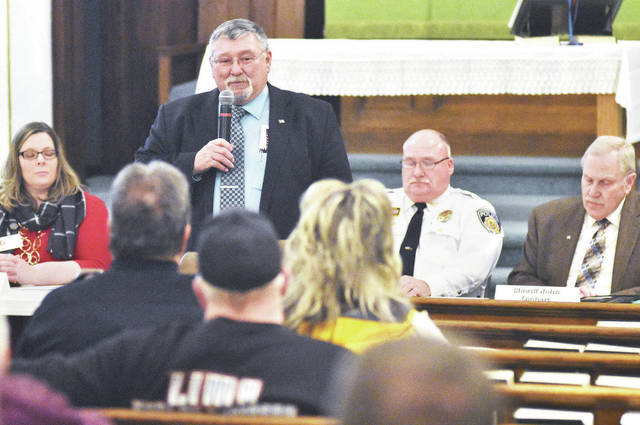
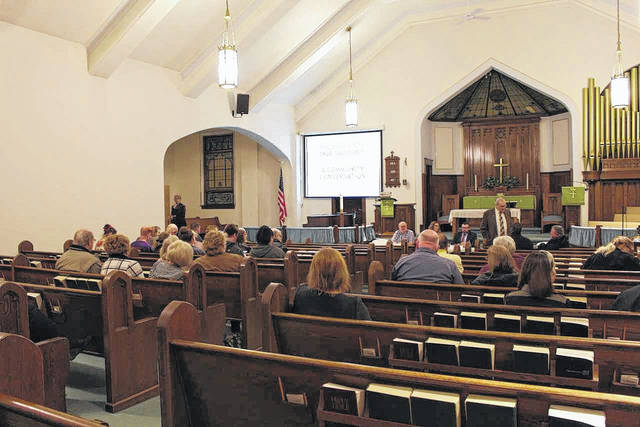
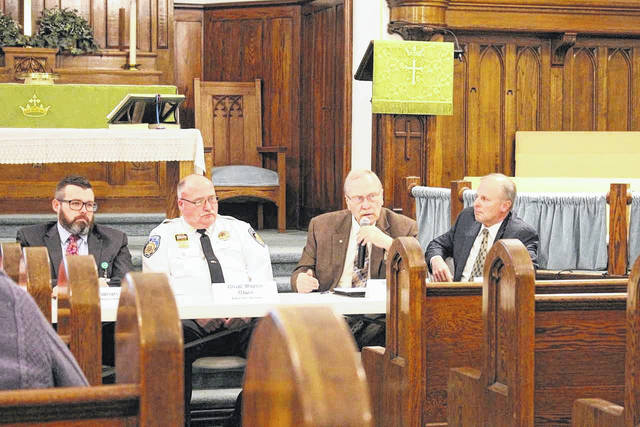
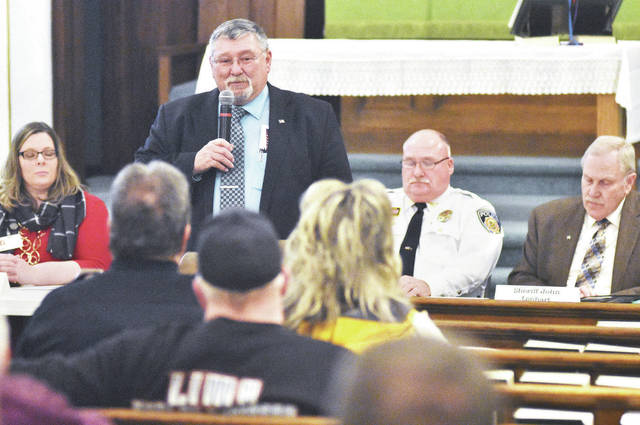
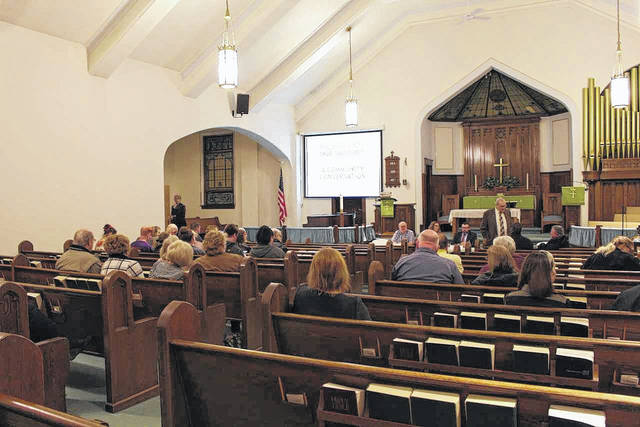
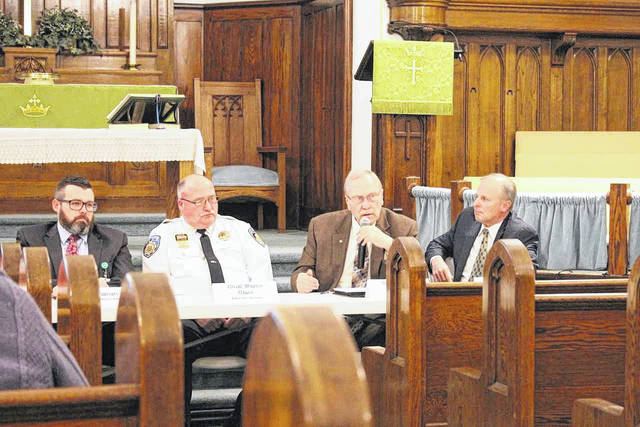
BOTKINS — The Shelby County Drug Task Force had its third Community Conversation, Tuesday, Jan. 23, at St. Paul’s Church, in Botkins, in an effort to continue its fight against opioid addiction through education, prevention and support.
This is the first time the event has been outside Sidney, and it drew a crowd of about 50 people.
Panelists in attendance were Tom Bey, of Shelby County Job and Family Services; Julie Clay, of Shelby County Counseling Center; Chief Wayne Glass, of Botkins Police Department; Robert Guillozet, Shelby County commissioner; Shelby County Sheriff John Lenhart; Dr. Stephen Roberts, of Wilson Health Emergency Department; and Timothy Sell, Shelby County prosecutor.
Scott Barr, executive director of the Shelby County United Way and member of the drug task force, was moderator for the event and began the evening by showing a short video from the Sidney chapter of Families of Addicts.
The video featured Cody Odom, director of FOA Sidney, and Trina Frasure, co-director. The mother and son duo discussed what role the opioid crisis has played in their own lives and how they became involved in addiction support.
“(Substance abuse) pretty much destroyed my family,” Frasure said. “I was found on the side of the road in Columbus. I had been beaten and raped pretty bad. I ended up on life support in the hospital and they told my family I wasn’t going to live.”
Frasure said at this point in her life, she had not spoken with her son in two years. She described this overdose experience as her “breaking point,” after which she decided to take the necessary steps toward being drug-free.
“I’m finally making those amends,” Frasure said. “Me and my family are getting closer; me and Cody are building a better relationship and my family is starting to trust me now.”
Frasure and Odom felt compelled to join together to help others who are in the throes of addiction, as well as their loved ones. After meeting with Lori Erion, founder of Families of Addicts, they started the Sidney chapter of FOA and began holding meetings in June of 2017.
Currently, FOA meetings are at 6:30 p.m. every Thursday in the Sidney Salvation Army, 419 Buckeye Ave.
After the video, Barr began a PowerPoint presentation showcasing opioid statistics at both national and local levels.
One staggering statistic Barr shared was that, according to the Centers for Disease Control and Prevention, more than 64,000 people died in 2016 from drug overdoses, and at least 91 Americans die each day from an opioid overdose.
Barr broke down the state-wide statistics of the evidence of drug use collected by the Bureaus of Criminal Investigation throughout Ohio. The data for Shelby County comes from the BCI lab located in London.
“In Shelby County, we are seeing meth, coke and fentanyl quite significantly,” Barr said.
Barr also pointed out the sharp increase in unintentional drug overdoses throughout the state within recent years.
“In 2012, we had just under 2,000 (unintentional drug overdoses), and as we come to 2016 data, that number was 4,050,” he said. “The year prior was 3,050.”
The substances involved in these overdose deaths include fentanyl and related drugs, heroin, cocaine, prescription opioids and benzodiazepines.
Barr analyzed the statistics behind the number of opioid prescriptions given to patients within the state throughout recent years and the change that is taking place at the hands of pharmaceutical companies.
According to the State of Ohio Board of Pharmacy, the number of solid opioid prescription doses dispensed to Ohio residents peaked in 2012 at 793 million doses.
“We have about a population in Ohio of 10.5 to 10.6 million people,” Barr said. “So, if you just do basic math off of these numbers, you could almost give every human being in the state of Ohio, of all ages, 70 pills.”
To curb the number of prescriptions being dispensed in further effort to combat opioid addiction, there is a pharmaceutical change taking place, which, Barr said, is becoming a new standard.
As of Feb. 1, 2018, CVS Pharmacy will limit new opioid patients to seven-day prescriptions with follow-up for pain management, eliminating any 30-day supplies of opioid medications.
Lenhart spoke briefly about the role of law enforcement in the fight against opioid addiction and the things he believes need to be done in order to create change.
According to Lenhart, the Shelby County Jail and its employees have worked toward facilitating the rehabilitation of many of its inmates, who are often imprisoned due to drug offenses, by giving them the opportunity to earn their GED, providing mental health assistance and by giving them work experience.
“(It has) turned us into kind of social workers,” he said.
Lenhart also spoke about the need for transitional housing and the crucial role it can play in the rehabilitation of those recovering from opioid addiction. He said a transitional housing facility is currently in the works for Shelby County.
Clay shared the counseling center’s work in the fight of opioid addiction by introducing and explaining the Vivitrol treatment program.
“Vivitrol is an injected shot every 28 days,” she said. “When you get that, you have a decrease in your thoughts and cravings, and it gives you the freedom to put treatment in place.”
Clay said the center currently offers an 18-month to two-year treatment program, which includes the use of Vivitrol. Clay emphasized the importance of effective and permanent recovery, which often takes an extended period of time to accomplish.
“We’re talking long-term here,” she said. “This isn’t something we want to fix overnight.”
After the PowerPoint and input from some of the panelists, the floor was opened to questions.
One question, directed toward Clay, was why drug users begin using in the first place.
“There isn’t one simple answer to that question,” Clay said. “It’s anything and everything. Sometimes when they’re teenagers, they experiment, and they find that that’s a good way to cope with life and then they get hooked. When addiction comes, it’s not picky. It doesn’t choose certain people. It will take anybody, and once you get to the point where you’re in a full-blown addiction, you no longer have a choice.”
Other questions included inquiries about the frustrations of those on the panel; what support is available for children of addicts; and whether or not the data presented includes statistics of those under 18.
“Fortunately, the number of drug cases we have in juvenile court in Shelby County is not great,” Sell said. “That’s where our hope is.”
The Shelby County Drug Task Force’s next meeting will be Feb. 13, at 9 a.m. They will discuss updates to the current fight against opioid addiction, as well as plans for future events and programs.




